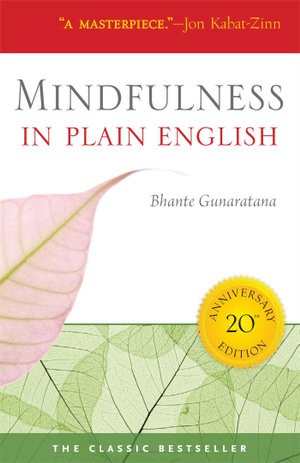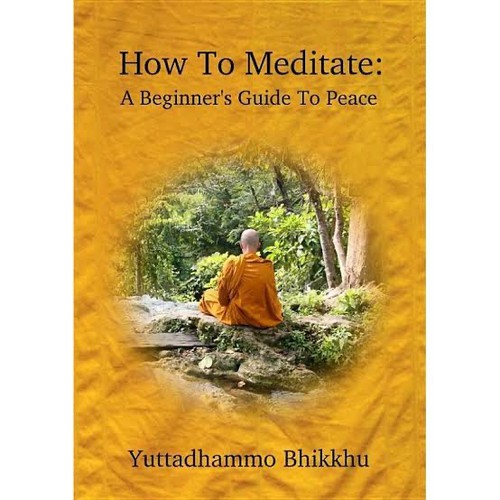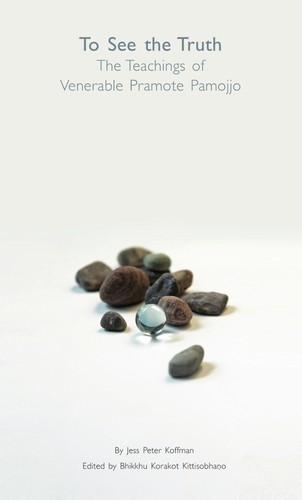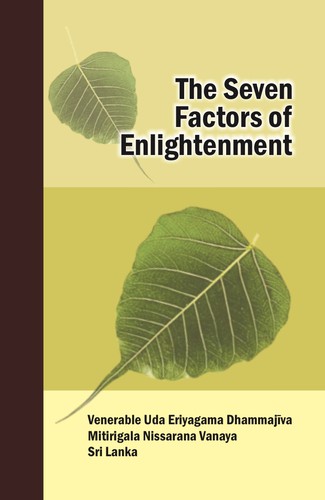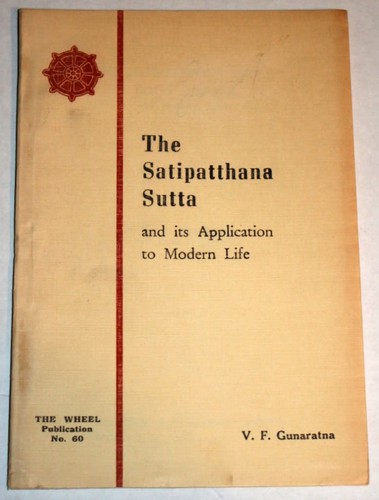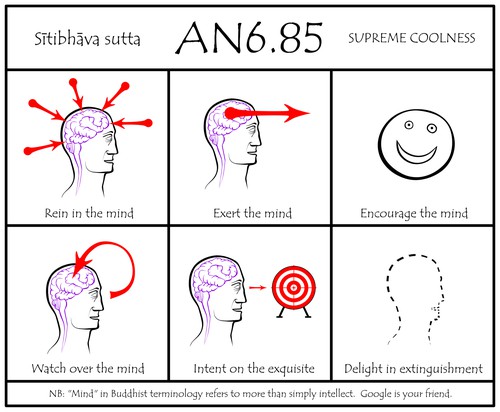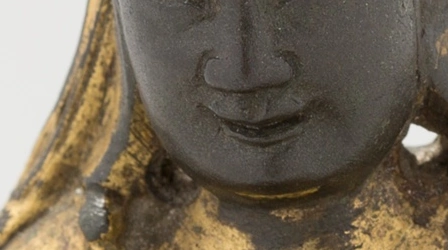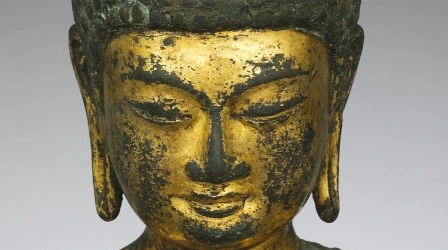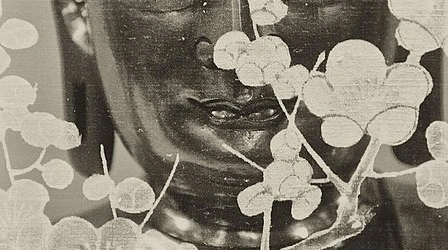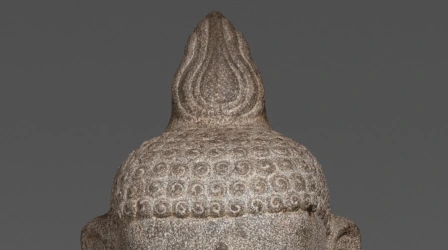Buddhist Meditation
Subscribe to this topic via: RSS
The training in wise attention.
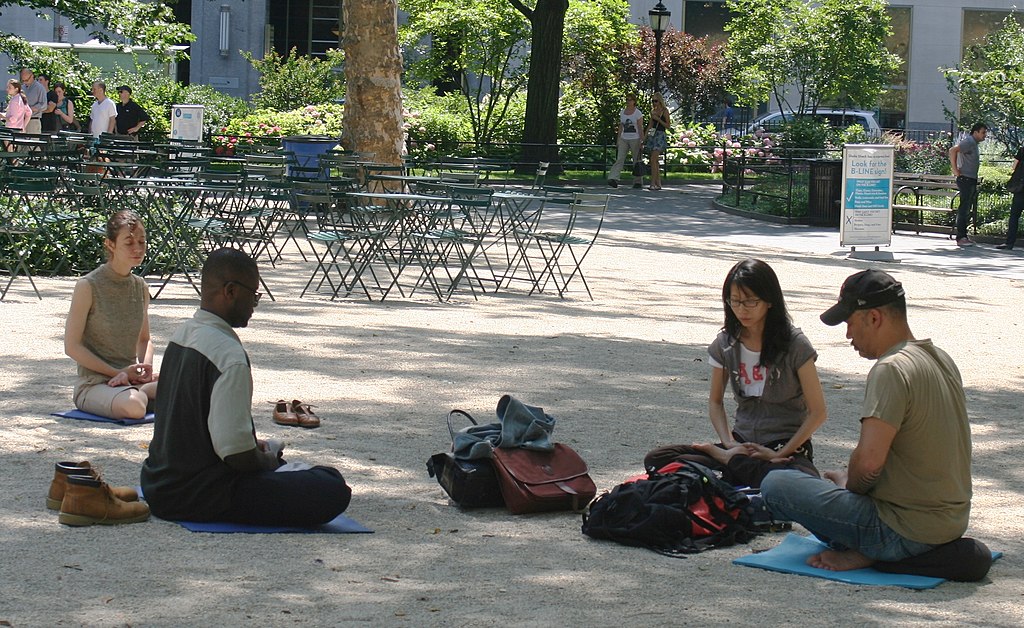
A small group of New Yorkers meditate together in Madison Square Park on a sunny Tuesday in June, 2010. (Beyond My Ken, CC BY-SA 4.0)
Table of Contents
- Books (26)
- Canonical Works (65)
- Readings (86)
- Audio/Video (40)
- Reference Shelf (1)
- Related Topics (7)
Books (26)
Featured:
-
⭐ Recommended
-
⭐ Recommended
In, out
Flower, fresh
Mountain, solid
Water, reflecting
Space, free -
🥇 Best of
-
… one gains firsthand understanding of the way things are, without reliance on opinions or theories, a direct experience, which has its own vitality. It also gives rise to the sense of deep calm that comes from knowing something for oneself
See also:
Canonical Works (65)
Featured:
-
⭐ Recommended
Here the Buddha details the seventh factor of the noble eightfold path—right mindfulness. This collects many of the meditation teachings found throughout the canon, especially the practices focusing on the body, and is regarded as one of the most important discourses in the contemporary Theravāda tradition.
-
⭐ Recommended
The Buddha gives a sixteen-step guided meditation on the breath and then explains how this meditation fulfills the four foundations of mindfulness and the seven factors of enlightenment.
-
⭐ Recommended
The Buddha explains how mindfulness of the body should be cultivated and to what benefits it leads.
-
⭐ Recommended
… when people put clean things, unclean things, excrement, urine, saliva, pus, or blood on the earth, the earth is not bothered, humiliated, or disgusted, in the same way, Rāhula, practice ‘peacefulness of earth’ meditation.
-
The (somewhat simpler) Mahasanghika parallel to the Satipaṭṭhāna Sutta.
-
The Buddha explains how he trains his disciples and why some succeed while others fail.
-
⭐ Recommended
This one thing, when developed and cultivated, leads solely to disillusionment, dispassion, cessation, peace…
-
⭐ Recommended
The faithful succeed, not the faithless. The ethical succeed, not the unethical. The energetic succeed, not the lazy. The mindful succeed, while the unmindful do not.
-
⭐ Recommended
These five things, when developed and cultivated, have freedom of heart and freedom by wisdom as their fruit and benefit.
-
⭐ Recommended
‘I’ve developed the heart’s release by love… Yet somehow ill will still occupies my mind.’
-
Mendicants, there are eight grounds for laziness.
-
There is a way of undertaking dhammas that is pleasant now and ripens in the future as pain. There is a way of undertaking dhammas that is painful now and ripens in the future as pain. There is a way of undertaking dhammas that is painful now and ripens in the future as pleasure. There is a way of undertaking dhammas that is pleasant now and ripens in the future as pleasure.
-
… how is a bhikkhu skilled in the ways of his own mind?
-
What six? Firstly, a noble disciple recollects…
-
… the god Kāmada said to the Buddha, “It’s too hard, Blessed One! It’s just too hard!”
-
Bhikkhus, develop concentration. A bhikkhu who is concentrated understands things as they really are.
-
Bhikkhus, suppose there is a guest house. People come from the east, west, north, and south and lodge there; khattiyas, brahmins, vessas…
-
⭐ Recommended
The five benefits of walking meditation.
-
⭐ Recommended
The meditative perceptions which act as antidotes for greed, hate, and delusion.
-
⭐ Recommended
O, that I might live for the interval that it takes to swallow having chewed up one morsel of food!
-
⭐ Recommended
… he should put forth extra desire, effort, diligence, endeavor, relentlessness, mindfulness, & alertness for the abandoning of those very same evil, unskillful qualities. Just as when a person whose turban or hair is on fire
-
Luminous, monks, is the mind.
-
Bhikkhus, these three kinds of unwholesome thoughts produce blindness, lack of vision, and absence of knowledge; they obstruct wisdom, lead to vexation, and are not conducive to Nibbāna.
-
Even in a confining place they find it,
the Dhamma for the attainment of unbinding. -
Here, with the subsiding of thought and examination, a bhikkhu enters and dwells in the second jhana, which has internal confidence and unification of mind, is without thought and examination, and has rapture and happiness born of concentration. This is called noble silence.
-
What is the mind’s stand?
-
When Venerable Bāhiya asks for a teaching to take on retreat, the Buddha teaches the four kinds of mindfulness meditation, well grounded on ethics.
-
The Buddha explains how his unique insights were gained by practicing the four satipaṭṭhānā meditations.
-
When one’s ferverous nature has been laid down…
See also:
Readings (86)
Featured:
-
🥇 Best of
… the common interpretation of the jhānas as absorption-concentration attainments [is] incompatible with the teachings of the Pāli Nikāyas. […] one attains the jhānas, not by one-pointed concentration and absorption into a meditation object, but by releasing and letting go of the foothold of the unwholesome mind […] the entrance into the first jhāna is the actualization and embodiment of insight practice.
-
🥇 Best of
Handicapped and at-risk Vietnamese youths share their appreciation of and enthusiasm for a mindfulness meditation course.
-
🥇 Best of
It’s interesting to walk through the graveyards of towns, and see that for the first few years after a person dies there may be a head stone, maybe someone remembers, but after twenty, thirty, or forty years, they could bulldoze the graves because the land is so valuable and plant somebody else in there. So even your head stone just crumbles to dust. All record of you living here is gone, because no one remembers who you were or what you did. Isn’t that beautiful? So why not do that right now? Bulldoze this idea of who you are
-
Participants in the concentration condition benefitted more if they had a high motivation to develop certain skills and a low motivation to seek spiritual experiences. Participants practicing humming showed greater treatment gains if they had a motivation to [relax]. In contrast, participants practicing observing thoughts benefitted more if they sought spiritual experiences and less if they aimed for relaxation or reduced stress. Finally, participants in the walking meditation condition experienced significantly better treatment effects if they were motivated to reduce stress, but benefitted less if they wanted to reduce suffering or sought spiritual experiences.
-
Combining academic and experiential study of the Satipaṭṭhānas, Bhikkhu Analayo sugests a new understanding of the four bases that he claims allows for more continuous practice and a unified understanding.
-
In an attempt to counterbalance the plethora of data demonstrating the relaxing and hypoarousing effects of Buddhist meditation, this interdisciplinary review aims to provide evidence of meditation’s arousing or wake-promoting effects by drawing both from Buddhist textual sources and from scientific studies, including subjective, behavioral, and neuroimaging studies during wakefulness, meditation, and sleep.
-
A total of 315 participants (26%) reported having had particularly unpleasant meditation-related experiences, which they thought may have been caused by their meditation practice. Logistic regression models indicated that unpleasant meditation-related experiences were less likely to occur in female participants and religious participants. Participants with higher levels of repetitive negative thinking, those who only engaged in deconstructive types of meditation (e.g., vipassana), and those who had attended a meditation retreat were more likely to report unpleasant meditation-related experiences.
-
… there is a place for “bare awareness” or “bare attention” within the early Buddhist scheme of meditation
-
This article explores to what degree meditation on the breath in early Buddhist thought involved focused attention. Closer inspection of instructions on this mode of meditation in the form of sixteen steps shows focused attention to be only a secondary aspect of the practice, which for the most part rather involves cultivating breadth of mind.
-
Despite heterogeneity of outcomes across studies, there is evidence that brief MBIs can impact numerous health-related outcomes after only one session and with interventions as brief as 5 min.
-
This study found that expert meditators show dramatically different connections in their Default Mode Network. Buddhist practice is not meant to smother (or enlarge) any one part of the brain (e.g. the amygdala), but rather to create the kinds of enduring, structural changes as these researchers found.
-
This model proposes four intervals in a cognitive cycle: mind wandering, awareness of mind wandering, shifting of attention, and sustained attention. People who train in this style of meditation cultivate their abilities to monitor cognitive processes related to attention and distraction
-
… hypnotic response and meditation involve opposite processes
-
mindfulness training may confer benefits greater than those associated with current standard treatments for smoking cessation.
-
While they won’t end racism, mindfulness and other contemplative practices do support ways of being in the world that reflect less of the biases that each of us holds
-
Changes in gray matter concentration were investigated using voxel-based morphometry, and compared with a waiting list control group of 17 individuals. Analyses in a priori regions of interest confirmed increases in gray matter concentration within the left hippocampus. Whole brain analyses identified increases in the posterior cingulate cortex, the temporo-parietal junction, and the cerebellum in the MBSR group compared with the controls. The results suggest that participation in MBSR is associated with changes in gray matter concentration in brain regions involved in learning and memory processes, emotion regulation, self-referential processing, and perspective taking.
-
There’s a way we want to spend our time, but we don’t do that because we don’t have the sense that time is short, time is precious. And the way to systematically raise the sense of urgency—Buddhism calls it samvega, spiritual urgency—is to bring the scarcity of time front and center in one’s consciousness: I am going to die. This show is not going to go on forever.
-
In his quest for awakening, according to the traditional account the Buddha tried and discarded various ancient Indian practices as being not in themselves conducive to awakening. Nevertheless, closer inspection shows that key elements of these practices became part of the Buddhist path, a transformation that involves mindfulness in one way or another.
-
Consistent with predictions, Monitor+Accept training reduced daily-life loneliness by 22% and increased social contact by two more interactions and one more person each day, compared with both Monitor Only and control trainings.
-
How the early Buddhist texts talk about “happiness.”
-
🥇 Best of
We, moderns but especially Americans, have a fundamental misunderstanding of cognitive development: we assume that higher-level functioning is always desired and so disparage and neglect fundamental cognitive skills.
-
When I first heard her story, I found myself wondering how on earth I could help a mother to overcome the grief of the loss of a son. Nothing gave Laila hope
-
The root of all of these
Is not taking your own mind to be paramount -
… a group randomly assigned to 5 days of meditation practice with the integrative body–mind training method shows significantly better attention and control of stress than a similarly chosen control group given relaxation training.
-
I knew I might be late for the morning talk if I didn’t hurry. Yet I didn’t
-
A quick word on the two main types of meditation.
-
⭐ Recommended
A few words on the sitting posture from a physiotherapist: what stretches to do and what pain to worry about.
-
A short paper listing the forty meditation objects of the Vissuddhimagga along with the kinds of people for whom it is said to be suitable.
-
Just one
-
Even as I work on eliminating the amplification of suffering, I can also turn to looking to ways I might start to amplify more life-serving experiences. Do I sense, anywhere in my body, a bit of well-being? Or even a bit of pleasure, or joy, appreciation, or love? Am I willing to let my attention rest there?
-
Here in Dzogpachenpo, we settle, without contriving, in what we call the essence of mind
See also:
Audio/Video (40)
Featured:
-
🥇 Best of
An engaging lecture at Spirit Rock on using text critical methods and personal practice to narrow in on an understanding of early Buddhist meditation practices.
-
🥇 Best of
A heartfelt and spellbinding talk on meditation practice and expectations.
-
A solid introduction to meditation in the Early Buddhist Texts.
4h 14 m -
Some introductory words on Buddhism and basic instructions for meditators.
-
We see all kinds of orientations, where someone’s neck is twisted, you can see their chin is pointing right, the chin is pointing left, the chin is pointing up… I see everybody misaligned in some gross or subtle way. When they get activated and the Qi is flowing in deep meditation, the Qi is going to want to jump that gap, pass through that gate into the brain. And what’s going to happen there?
-
The life enriched by meditation is three dimensional: it’s not a completely different realm, it’s providing a new and clearer perspective.
-

-
Bhikkhu Analayo briefly introduces his research and practice of the Satipaṭṭhāna Sutta, including his own gradual way of practicing the four establishments based on he feels are their essential qualities.
-
A psychologist sits down with an Australian wellness reporter to talk about the nascent field of compassion research.
-
What is it like when the mind is at rest? Did that happen today? How does it come about?
-
The mind becomes clearer and clearer and you will be delighted.
1h 15 m -
There are two kinds of meditation, samatha and vipassana. Samatha (or “tranquility” meditation) offers a break from life. Vipassana (or “insight” meditation) is our chance to learn from life.
24 min -
⭐ Recommended
A blur in the periphery,
like the mind if the mind
were airborne, a buzz…5 min -

-

-
Meditation is not a pill.
-
Here I am, holding one more
mirror. This time smoke…5 min
See also:
Reference Shelf (1)
-
A digital, guided meditation exploring the parts of the body.
